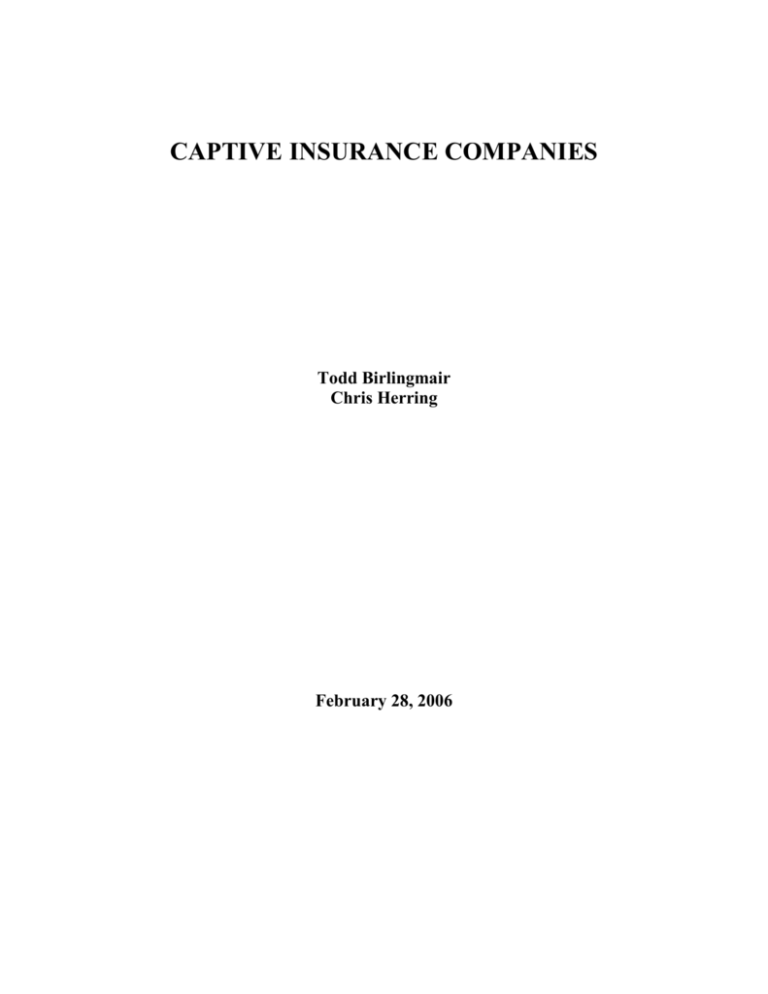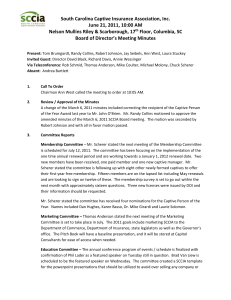"Captive Insurance Companies" ()
advertisement

CAPTIVE INSURANCE COMPANIES Todd Birlingmair Chris Herring February 28, 2006 Abstract Rising commercial insurance costs and difficulty in obtaining certain types of insurance coverage has resulted in businesses reviewing “alternative risk transfer” (ART) vehicles. One of these alternatives is to form a captive whereby the insurance company is owned by the insured. “In its 2003 study, The Picture of ART, Swiss Re estimated that the global market for alternative carriers, consisting of self insurance, captives, risk retention groups and pools, accounted for about $88 billion in premiums in 2001, and projected that the market will grow about 10 percent per year through 2005.”1 Captives are gaining momentum in use by corporations and are changing the landscape of the insurance industry. Our research paper will review why captives are formed, benefits and costs of operating, types and uses of captives, and responsibilities and regulation governing use. We will then look at how captives are impacting taxing authorities, if they are an effective risk management tool, monitoring issues and who should regulate. Introduction Risk management is about protecting assets. The primary risk management tool corporations have is insurance to transfer certain risks at a fixed cost. Self insurance has become a viable alternative to traditional insurance when obtaining coverage outweighs the benefits of transferring the risk to a third party. A captive is a legitimate insurance arrangement for tax purposes if separate legal entities are correctly setup by the parent, captive and insured to appropriately transfer risk. The legal structure is important in order for the captive to be treated as insurance so that the premiums may be deductible. The ability for corporations to use the captive to accept various layers of risk and manage their own claims has resulted in implementation by several large companies. Many corporations inherently assume risk for 2 different exposures but a captive essentially allows reserves to be setup in a tax advantaged manner. 2 Literature Review Why are Captives Formed? The following summarizes the primary benefits and economics reasons to form a captive: 1. Lower insurance costs - Corporations know their loss experience and risks better than an insurer. However, insurers must charge a premium commensurate with other commercial companies. Included in the premium charged are the administrative costs of the insurer and a profit margin, which can represent almost 40% of the total. Therefore, corporations may want to retain that profit by setting up their own captive to underwrite their insurance. 3 2. Cash flow and investment income– Corporations can improve their cash flow by deciding when to pay the insurance premiums. The insurance premiums paid can be invested in an offshore domicile and untaxed. The investment income can be a primary component of the savings due to the time difference of when the premiums are paid versus the claim. This savings is then captured by the captive rather than the insurance company. 3 3. Risk retention - Corporations that can retain more risk may not be offered a deductible with an adequate premium to compensate them for the additional risk. With a captive, reserves can be setup to manage this risk at a fair price. 4. Unavailability of coverage – Commercial insurance may be limited or unavailable and therefore a captive may be the only choice for insurance. 3 3 5. Risk management – Captives can force organizations to do a better job of managing and financing risk. The different divisions within an organization can have more flexibility in insuring for risks suitable for their individual business. The insurance market changes from soft to hard for coverage and captives give a place for a company to store risk. The ability to use reserve funds to manage different exposures is advantageous. 3 6. Access to the re-insurance market – Forming a captive will allow corporations to deal directly with re-insurers. This may result in customized insurance coverage, and lower premiums due to the size of the re-insurance market. The re-insurance market provides more flexibility in how corporations can develop their risk management program. 3 7. Writing unrelated risks for profit – Captives allow corporations to underwrite risks to third parties. For instance, retailers could provide warranties to customers since they have insight into possible losses making this a profitable business. 3 8. Tax minimization – Professional tax planning is essential in developing a strategy to allow premiums paid to the captive to be tax deductible. Issues such as domicile of the parent and captive are important considerations in determining setup. 3 9. Facilitate Business Planning and Cost Allocation – Captives better allow diverse companies to allocate costs of risk management to each division and shift risk as necessary between companies. 4 4 Types and Uses of Captives Captives are used for a variety of reasons and therefore many different types have been developed such as the following: 1. “Single-parent captives - underwrite only the risks of related group companies.”3 2. “Diversified captives - underwrite unrelated risks in addition to group business” 3 3. “Association captives - underwrite the risks of members of an industry or trade association.” 3 4. “Agency captives - formed by insurance brokers or agents to allow them to participate in high-quality risks, which they control.” 3 5. “Rent-a-captives - insurance companies that provide access to captive facilities without the user needing to capitalize his own captive.” 3 In this type of captive, the user pays a fee and will be required to provide some form of collateral so that the rent-a-captive is not at risk from any underwriting losses suffered by the user. 6. “Special purpose vehicles (‘SPV’s) – “They are reinsurance companies that issue reinsurance contracts to their parent and cede the risk to the capital markets by way of a bond issue.” 3 Onshore versus Offshore Captive Domiciles Captives were previously formed offshore in tax haven jurisdictions like Bermuda or the Cayman Islands due to fewer regulations. Almost half of the U.S. states now have enacted captive insurance regulations in hopes of capturing some of this business.2 The top domiciles of captives as of 2004 are listed in the chart below: 5 LEADING CAPTIVE DOMICILES Rank Location 2004 1 Bermuda (1) 1,150 2 Cayman Islands 694 3 Vermont 524 4 Guernsey 410 5 British Virgin Islands 350 6 Barbados 257 7 Luxembourg (1) 219 8 Dublin 214 9 Isle of Man 175 10 Turks & Caicos (2) 164 11 Hawaii 147 12 South Carolina 114 13 Singapore 57 14 Switzerland 50 15 District of Columbia 40 Source: www.iii.org/media/hottopics/insurance Regulatory oversight in the offshore locations has increased recently allowing states such as Vermont now to compete for these tax dollars. Vermont has enacted legislation requiring no premium minimums, accepts most commercial insurance coverage, they have minimal capital requirements, a favorable tax structure, and no investment restrictions. 5 The differences in oversight between locating a captive onshore or offshore may be insignificant enough that the primary determination in location is if the insurance risks covered will be domestic or foreign.2 Costs of Forming a Captive The implementation costs of setting up a small captive program can be approximately $100,000 in the first year. These costs may vary depending upon the legal and professional services required. Annual management fees to keep a program operating can run about $50,000 a year. These expenses may be prohibitive for smaller businesses to form a captive and require companies to undertake feasibility studies before a decision is made to form a captive. Another 6 consideration will be the amount of minimum reserves required to be deposited in a bank before a license can be issued. Since the captive is considered an insurance company, ongoing expenses for outside services such as auditing, accounting, and banking will be required. 4 Current Regulatory Environment and Legislation The Sarbanes Oxley Act requires that captives owned by public companies need to comply with all of the regulations and governance in this legislation. Sarbanes Oxley attempts to provide better governance through accountability of board members to their shareholders. Changes in regulatory rulings have been beneficial towards captives the past few years. The Internal Revenue Service changed a ruling in June 2001 to allow premiums paid for captive insurance to be tax deductible, which was contrary to their previous rulings. However, Insurance practices became more scrutinized in 2004 when New York Attorney General Elliot Spitzer began probing offshore operations of insurance businesses including captives. 1 Captive laws are now enacted in 23 states and the District of Columbia. Most states have passed risk retention laws, which are now part of their state insurance codes. “One of the issues is whether a state can require an insurer not licensed to do business in that state to comply with its licensing laws. An increasing number of states now require a purchasing group insurer to meet surplus lines insurer requirements before insuring members of the group and to file forms and rates for regulatory approval.”1 Offshore captives such as the Bahamas are supervised through the Office of the Registrar of Insurance Companies. There are guidelines to specify reporting requirements to comply with regulations but the Registrar may have stricter standards for companies engaging in risk that is considered higher than normal. 9 7 Current Issues: How are captives impacting taxing authorities? Many companies may set up a captive insurance company to enjoy certain tax benefits. Some of the current issues involve whether or not the captive is being used as a real insurance company or is just a front so that the parent company can enjoy certain tax benefits on the premiums it is paying. Also, in some states like Vermont the captive insurance company has some other tax benefits. Under Vermont law the premiums are taxed at a max of .4%. Also, the captive can invest these premiums to make money for the parent company. The profits on the investment of the premiums are not taxed by the state. The corporate income tax of Vermont is around 7% to 9%. These tax breaks were set up by, then, Governor Dean to attract more captive insurance companies to the state of Vermont. He wanted Vermont to become an “ onshore Bermuda.” 6 Under the U.S. tax code for the premiums to the captive to be tax deductible 50% of the captives business must be unrelated to the parent company. The business must deal with risk. Ways that the captive can do business with other entities is to offer reinsurance, or offer insurance plans to employees of the parent company. The parent company cannot have anything to do with the support of the captive insurance company. The premiums charged by the captive cannot be excessively high or low compared to the rest of the insurance industry.11 There must also be a clear shifting of risk from the parent company to the captive. If these two criteria are not met it is argued that there isn’t enough diversification of risk. It has been argued that if a captive gets over 50% of its premiums from the parent company then the company is not set up for insurance. It would be considered a “sham corporation.” These corporations are only set up 8 for tax purposes. To meet IRS requirements most companies will create multiple LLCs. These are created to meet the over 50% premium requirement. The LLCs for most of these companies are disregarded entities for tax purposes. To meet the 50% requirement the LLCs must decide to be treated as their own corporations. This way the captive can claim that over 50% of their business and premiums are dealing with other entities besides the parent company.12 Another major issue is the fact that many states believe that captives are causing many states to lose valuable tax revenue. The federal government is also losing tax revenue due to the ability to take federal deductions on the premium payments to the captives. Also, because Vermont, certain other states and Bermuda offer tax breaks, many other states have to compete and create tax breaks for the captives. In 1996 the Clinton administration tried to put a stop to the federal tax breaks for companies who create captives. According to Michael Kranish of the Boston Globe, if the Clinton Administration had their way, most of the captive insurance industry would have been killed. Howard Dean opposed this plan and eventually got his way. 6 Are captives an effective risk management tool? Captives would appear to be effective in managing risk. Some of the reasons that a company would set up a captive are to be more flexible in handling risk financing and to lower premium costs. There are of course the tax benefits. When someone looks at the benefits of a captive insurance company, they probably want to look at how the formation of this company impacts risk management. With a captive the parent company can put away funds to use for future insurance losses. Some other benefits would be the ability of the captive to provide direct access to the reinsurance market and allows the company to generate other revenue by offering insurance to 3rd party organizations.7 9 It would appear to me that captives are effective for the companies that form them. They are being formed at an impressive rate in the United States and in offshore domiciles. Perhaps the most famous captive company would be Allstate. It is of course an independent company at the present, but it was originally set up as a captive insurance company by Sears & Roebuck Co. Other companies have captives as well. Caterpillar has formed their captive under their finance arm. General Mills formed Gold Medal Inc. to be their captive insurance company. There are now more than 3900 captive insurance companies and that number is continuing to increase.7 The state of Vermont has over 500 of those captives, but most reside on offshore domiciles. Vermont has more captives than the other 49 states combined.6 Based on the fact that the number of captive companies is continuing to increase and the fact that there are many benefits to form them, it would appear that they are effective risk management tools. They allow a company to easily transfer risk to their subsidiary. Forming a captive allows a company to easily put back money to save for losses and other types of risk. They are also a good way to generate more revenue by taking on 3rd party insurance or providing reinsurance to other insurance companies. Monitoring risks? Some of the issue surrounding captives are the fact that some companies create them without them being properly capitalized. They are trying to create them for other purposes besides insurance. There is the possibility of inadequate loss reserves. Some companies may initially project losses and then create reserves and pay premiums to cover those expected losses, but a lot of times the case can be that there is not adequate capital to handle unexpected losses.13 10 The way that a captive is usually monitored is by the CFO or the Risk Manager of the parent company. The company also will employ auditors to watch over the captives. They will use their own internal auditors or they will hire an outside auditing firm, such as one of the big 5 accounting firms, to audit the company. Captives are required to provide audited financial statements to their respective regulators on an annual basis.12 Other ways to monitor the captive company is to use another company. Companies such as AON provide services for helping to set up captives. They also provide services, such as auditing, helping to prepare financials and the types of investment vehicles that should be set up for the captive. Other services they provide are legal assistance, help in forming the claims procedures and will help in forming the insurance agreements.14 Another way companies can monitor the captive is by requesting that A.M. Best do a rating analysis. This way they can make sure everything is in order with the captive and see how they stack up with their rating. The first step is for the captive to make a request for an analysis. This is only done on the initial rating analysis. A.M. Best will meet with the company’s management, request financial documents and audit the company to form their rating. They will then determine the rating and then release it publicly. After the initial analysis there is ongoing monitoring and there will be public releases of the rating. There will be an assigned analyst to the company. The analyst will keep a dialogue open with the company and they will work together when there are big changes in anything the company does. This will allow an outside independent and reputable agency to keep tabs on what the company is doing. It will make sure that the company is doing everything correctly and also will ensure that everything is in order with the financials and the way the company is being run. This also allows other companies, 11 which may want to do business in the future with the captive, to maintain a watch on how the captive is doing.15 Who Should Regulate Captives? Captives are regulated differently compared to other insurance companies. A regular insurance company, who serves the public, is different than a captive that is basically just serving its parent company. “When insuring the general public, the insurer must conduct itself with a view to matters that the captive owner need not concern himself with such as discrimination in rates and forms, availability to all qualified applicants, and participation in required pools.”8 Just like regular insurance the captives are also regulated on a state-by-state basis. The states that generally regulate the captives are the domiciles that they are headquartered in. They must meet their regulations first of all. There is currently a push among some to go to federal regulation of the insurance industry instead of a state-by-state thing. There is a fear among captives though, that if it goes to federal regulation, that the federal government will decide to over regulate the captive industry. The captive industry believes that they are too diverse to be put under one regulatory authority. One captive may be in existence for different reasons than another captive.8 State-by state regulation would probably be good for captives. This puts everything more on a regional basis. Certain captives are headquartered in certain domiciles for many different reasons. State-by-state would allow the captive to still choose which domicile they wish to work in. Also, if there was a national regulation instead of state-by-state a lot of the captives my go offshore so that they don’t have to deal with any rigidity that might happen. 12 Conclusion: There appears to be no end in sight for captives. Captives are created for many reasons. Some are created for tax reasons and others are created because the company needs a cheaper source of insurance. Captives, in the United States, are growing and becoming stronger. There is also a push among captives to do more business with other companies besides the parent. One captive that eventually became a full multi line insurer would be Allstate. Based on the literature review it would appear that the direction of captives is more towards the Allstate model. Several captives are now offering insurance to other companies. The new tax laws have forced this issue. The IRS decided in 2005 that for a company to enjoy the federal tax benefits on premium payments that the captive had get at least 50% of its premiums from some company other than the parent company. This is because the IRS believed that before there was not enough diversification of risk. Parent companies have gotten around this by forming LLCs. 13 References: 1.“Captives & Other Risk-Financing Options”, www.iii.org/media/hottopics/insurance/test3 January 2006 2.“Captive Insurance: Benefits and Responsibilities”, Jay Adkisson and Chris Riser www.assetprotectionbook.com/captive_insurance.htm 3. “Captive Insurance Companies – What Are They” By Martin Eveleigh ACII www.captive.com/service/kpmg/kpmg_article2.html 4. “The Need for Captive Insurance” www.cyberhaven.com/offshorelibrary/captive.html 5. “Vermont, The Largest Onshore Captive Domicile: http://www.vcia.com/vtdomicile.htm 6. “US: For Dean, 'Captive' Insurance a Vermont Boon”, Michael Kranish, Boston Globe, December 12th, 2003 7. “Why Dream of Captives in Today's Insurance Market?, Nathan Shpritz and Alison Calder; Liberty Mutual Group 8. “Regulation of Captives: Who? Why? What Next? Michael R. Mead, M.R. Mead & Company, LLC, August 2005, www.irmi.com/Expert/Articles/2005/Mead08.aspx 9. “Captive Insurance in The Bahamas”, Source: Registrar of Insurance Companies www.bahamas.gov.bs/BahamasWeb/businessandfinance.nsf/Subjects/Captive+Insurance! 10. “Return of the Company Store”, David M. Katz, CFO.com, May 2003, www.cfo.com/printable/article.cfm/3009118?f=options 11. “Tax Update & Impact of Latest IRS Captive Rulings”, Thomas M. Jones, Bermuda Captive, Sept. 2005, www.bermudacaptive.bm/2005-archive/attendees-presentations/TaxUpdate.ppt 12. “Captives: Here to Stay”, Rosemary M. McAndrew, McAndrew Risk Management, Inc., December 2003, www.businessforum.com/RMM_01.html 13. “Captive Overview”, Captive Insurance Alternatives LLC, Sept 2004, www.captiveinsurance-alternatives.com/l_overview.htm 14. Captive Management Services, AON Inc, www.aon.com/as/en/risk/captive/mgmt.jsp 15. “AM Best’s Rating Methodology for Captive Insurance Companies”, Henry K Witmer, A.M. Best, November 2005, www.ambest.com/ratings/methodology/domesticcaptives.pdf 14 15








